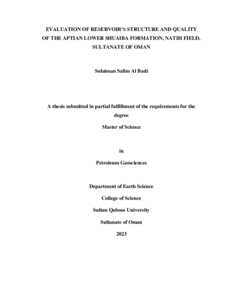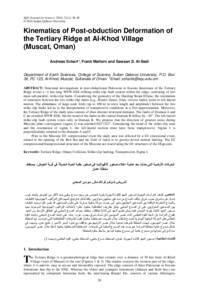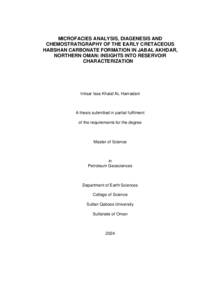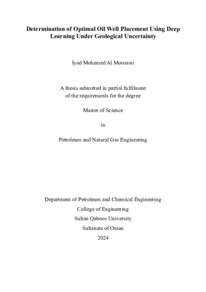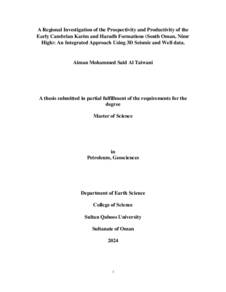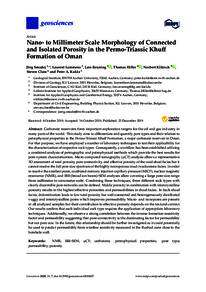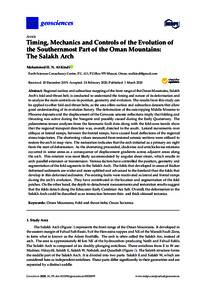Document
Evaluation of reservoir’s structure and quality of the aptian lower Shuaiba Formation in Natih Field, Sultanate of Oman.
Source
Master's thesis
Other titles
تقييم تركيبة وجودة مكمن تكوين شعيبة السفلي في حقل ناطح بسلطنة عمان
Country
Oman
City
Muscat
Publisher
Sultan Qaboos University
Gregorian
2023
Language
English
Thesis Type
Master's thesis
English abstract
The Aptian Lower Shuaiba reservoir is one of the main hydrocarbon reservoirs in
Northern Oman, which has been extensively studied. However, the Shuaiba reservoir in
Natih field in northern Oman is poorly understood. Through the analysis of the available
data, a structure model, depositional and facies model, diagenesis understanding, reservoir
quality, and new opportunities are studied. The project studies both blocks of the Natih
fault, the upthrown and the downthrown blocks.
Different models have been developed to better understand the Shuaiba reservoir
in the Natih field. Starting with the structure model, and based on seismic attributes as well
as seismic cross-sections, the majority of the faults at the Shuaiba level in the upthrown
block are trending NE-SW. In addition, the maximum fault throw in the upthrown block
is 7 m, with an average throw of 3 m. The results of this analysis confirm the efficiency of
Nahr Umr sealing since the average Nahr Umr thickness in the Natih field is 130 m.
Moreover, the Natih fault is a reverse fault that was most likely moving as a strike-slip
fault, with locally being transtensional or transpressional during the Alpine 1 event,
depending on the geometry of the fault trajectory. Next, three facies have been identified
in the upper 35 m of the Shuaiba reservoir. The three facies are oncodidal packstone,
which was most likely deposited in a shoal flank setting; bioclastic mudstone, which was
most likely deposited in an open marine shelf; and bioclastic wackstone, which was most
likely deposited in a shallow marine shelf. However, the diagenesis model shows that early
and late cementation with dissolution has affected the Shuaiba reservoir in the Natih main
field, as well as compaction and fractures. In addition, the diagenesis model shows that the
faulted/fractured areas have been cemented due to the highly saturated salt fluids that went
through the faults/fractures and led to cementation in the surrounding areas.
In terms of the new opportunities, the downthrown block might be a good
opportunity to test. The petrophysical logs show a good reservoir quality with hydrocarbon
saturation. Moreover, seismic attributes are used as hydrocarbon indicators, which show
the probability of the presence of hydrocarbon in the downthrown of the Natih fault. As a
recommendation, the top structure of the Shuaiba reservoir in the downthrown block is
recommended to be drilled.
Arabic abstract
يعد مكمن شعيبة السفلي أحد المكامن الهيدروكربونية الرئيسية في شمال عمان، والذي تمت دراسته على نطاق واسع. ومع ذلك، فإن مكمن شعيبة في حقل ناطح في شمال عمان غير مفهوم جيدًا. من خالل تحليل البيانات المتاحة، تتم دراسة نموذج التركيب، ونموذج الترسيب والسحنة، وفهم عملية التطور، وجودة المكمن، والفرص الجديدة. يقوم المشروع بدراسة كتلتي صدع ناطح، الكتلة الصاعدة والهابطة. بشكل أفضل. بدءا التركيبي إلى الخصائص ً تم عمل نماذج مختلفة لفهم مكمن شعيبة في حقل ناطح من النموذج ، واستناداً الزلزالية وكذلك المقاطع العرضية الزلزالية، فإن غالبية الصدوع عند مستوى الشعيبة في الكتلة الصاعدة تتجه نحو الشمال الشرقي والجنوب الغربي. بالاضافة إلى ذلك، الحد الاقصى لرمية الصدع في الكتلة الصاعدة هو 7 أمتار، بمتوسط رمية 3 أمتار. وتؤ كد نتائج هذا التحليل كفاءة سد نهر عمر حيث إن متوسط سمك نهر عمر في حقل ناطح يبلغ . عالوة على ذلك، فإن صدع ناطح هو صدع عكسي كان على الارجح يتحرك كصدع انزالقي، مع كونه 130 متراً عابرا للشد أو متقاطعًا محليًا أثناء حدث الالب الاول اعتمادًا على هندسة مسار الصدع. وبعد ذلك، تم التعرف على ثالث سحنات في الـ 35 مت ًرا العلوية من مكمن شعيبة. السحنات الثالث هي اونكويال باكستون، والتي تم ترسيبها على الارجح في محيط المياه الضحلة؛ الحجر الطيني الحيوي، الذي تم ترسبه على الارجح في جرف بحري مفتوح؛ وواكستون الحيوي، الذي تم ترسبه على الارجح في جرف بحري ضحل. ومع ذلك، يوضح نموذج التحلية أن عملية التثبيت المبكر والمتأخر مع الذوبان قد أثرت على مكمن شعيبة في حقل ناطح الرئيسي، وكذلك على الدمك والكسور. بالاضافة إلى ذلك، يوضح نموذج التشوه أن المناطق المتصدعة/المكسورة قد تم تدعيمها بسبب السوائل المالحة عالية التشبع التي مرت عبر الصدوع/الكسور وأدت إلى التماسك في المناطق المحيطة. وفيما يتعلق بالفرص الجديدة، قد تكون الكتلة الهابطة فرصة جيدة لالختبار. تُظهر السجلات البتروفيزيائية جودة جيدة للمكمن مع تشبع بالهيدروكربون. عالوة على ذلك، يتم استخدام الخصائص الزلزالية كمؤشرات هيدروكربونية، والتي توضح احتمالية وجود الهيدروكربون في كتلة ناطح الهابطة. كتوصية، يوصى بحفر الهيكل العلوي مكمن شعيبة في الكتلة الهابطة.
Category
Theses and Dissertations

